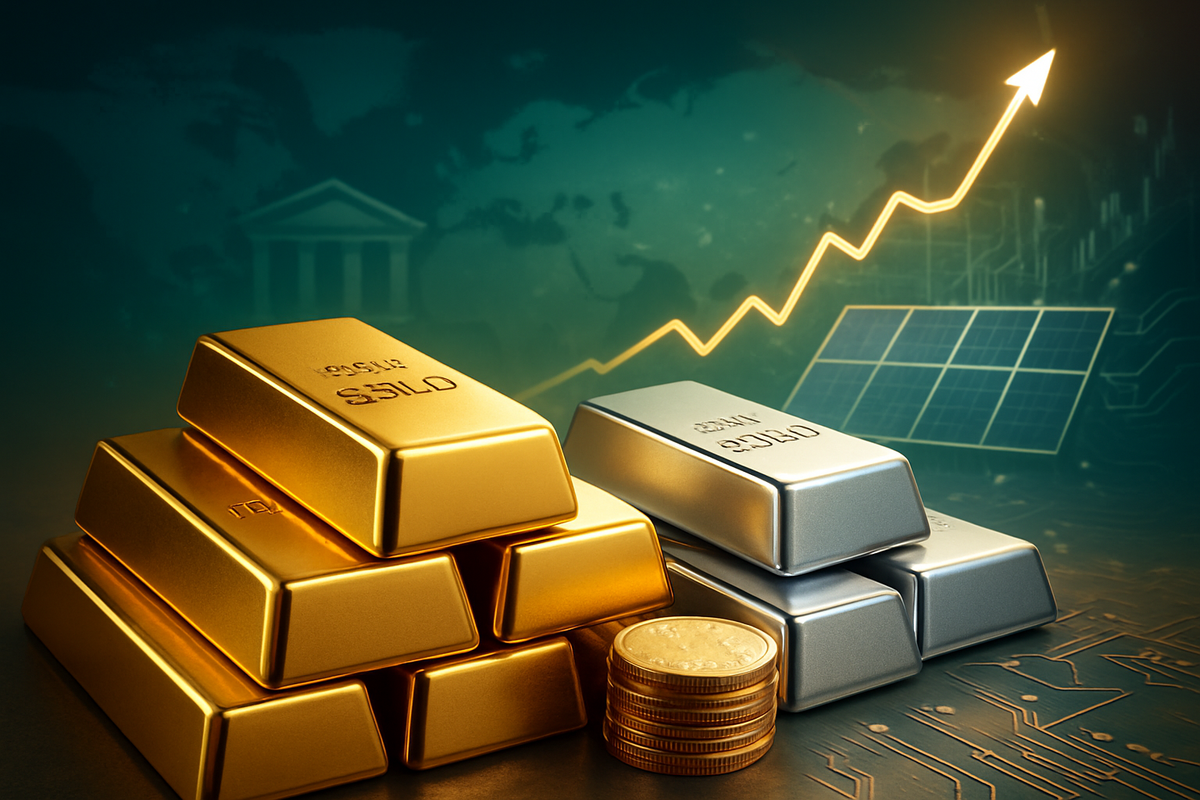
November 12, 2025 – The global financial markets are witnessing a significant and sustained bullish trend in both gold and silver, driven by an accelerating confluence of robust demand and only modest increases in production. As of November 2025, while the supply chains for these crucial precious metals are seeing marginal expansions, these gains are proving largely insufficient to meet surging global appetite. This imbalance is fundamentally reshaping market dynamics, pushing prices higher and solidifying the role of gold as a strategic reserve asset and silver as an indispensable industrial commodity.
The current landscape is marked by an unprecedented surge in demand from central banks for gold, coupled with an escalating industrial need for silver, particularly from the rapidly expanding green technology sectors. This dual-pronged demand pressure, against a backdrop of constrained mining output and dwindling above-ground inventories, paints a clear picture of a market entering a prolonged period of scarcity and elevated valuations. Investors and nations alike are increasingly turning to these tangible assets as hedges against economic uncertainty, inflation, and geopolitical volatility, signaling a decisive shift in global financial strategies.
The Scarcity Squeeze: Modest Production Meets Unprecedented Demand
The narrative of expanding gold and silver production in 2025 is nuanced, characterized by marginal increases that are consistently outpaced by an insatiable global demand. For gold, global supply is projected to see a modest increase of approximately 1% in 2025. This incremental growth is primarily supported by minor gains in mining output and intensified recycling efforts. However, the gold mining sector faces significant structural impediments that prevent more substantial expansion. These include escalating production costs, driven by energy price inflation and persistent labor shortages, alongside declining ore grades that necessitate processing larger volumes of material for the same gold recovery. Furthermore, extended project development timelines, often exacerbated by complex permitting processes and stringent environmental regulations, continue to restrict the opening of new mines. Notably, the United States has not seen a new gold mine open since 2002, underscoring the formidable challenges in expanding capacity.
The true game-changer in the gold market, however, lies in the unprecedented demand from central banks. Through September 2025, central banks globally have added an astonishing 634 tons of bullion to their reserves, with full-year 2025 purchases forecasted to range between 750-900 tons. This sustained buying spree, particularly by emerging market central banks such as China, Poland, Turkey, and Kazakhstan, represents a strategic pivot towards de-dollarization and diversification of national reserves. It marks the most prolonged period of institutional buying in modern financial history, fundamentally altering global supply-demand dynamics. Beyond sovereign entities, institutional and Western investor demand for gold has also made a decisive return in 2025. This trend is clearly evidenced by strengthening inflows into gold-backed Exchange-Traded Funds (ETFs), with global gold ETF assets under management (AUM) reaching a record high of US$503 billion by the end of October 2025, encompassing holdings of 3,893 tons. Even smaller players, like Asia Broadband Inc. (OTCQB: AABB), have been strategically accumulating physical gold holdings, reporting significant unrealized gains of over 100% on their reserves, estimated at a market value of $76 million.
Similarly, the silver market, while anticipating a modest 2% increase in global supply for 2025, is grappling with an even more acute supply shortage crisis. This projected increase, largely driven by gains in Mexican output, still leaves total production at 835 million ounces, significantly lower than the 900 million ounces produced in 2016. A critical characteristic of silver production is that only about 20% originates from primary silver mines, with the vast majority being a byproduct of mining other metals like copper, lead, and zinc. This reliance on other metal mining output makes silver supply less responsive to direct silver price signals. The market has been in a structural deficit since 2021, with cumulative shortfalls totaling almost 800 million ounces between 2021 and 2025, indicating that demand continues to consistently outpace supply. Investment interest in silver ETFs has also seen a resurgence, with holdings increasing by 15 million ounces in the first quarter of 2024. More alarmingly, COMEX registered silver inventories have drastically declined from over 150 million ounces in 2020 to approximately 35 million ounces in early 2024, representing a staggering 77% reduction in readily available warehouse stocks. This accelerated depletion of above-ground inventories is intensifying physical market tightness and setting the stage for significant price volatility.
Corporate Fortunes in the Precious Metals Rush: Winners and Challengers
The escalating prices and persistent demand for gold and silver are creating a discernible divide among public companies, with those deeply entrenched in the mining and streaming sectors poised for significant gains, while industries reliant on these metals as raw materials face mounting cost pressures. As of November 2025, a bullish sentiment pervades the precious metals market, with gold prices consistently setting new highs, surpassing $4,300 per ounce in October and projected to average $3,675/oz by Q4 2025 and climb towards $4,000/oz by mid-2026. Silver, demonstrating its dual role as a safe haven and critical industrial metal, has also seen remarkable surges, touching $54 per ounce in October and exceeding $53 in November 2025, with projections suggesting it could potentially outperform gold and reach $56 per ounce.
Mining and Royalty Companies: Riding the Wave
The primary beneficiaries of this precious metals boom are undoubtedly the gold and silver mining companies with efficient operations, low All-In Sustaining Costs (AISC), and robust balance sheets. Higher precious metal prices directly translate into increased revenue per ounce extracted, significantly boosting profit margins and cash flows due to inherent operational leverage. Major gold producers such as Barrick Gold Corporation (NYSE: GOLD; TSX: ABX), Newmont Corporation (NYSE: NEM), Agnico Eagle Mines Limited (NYSE: AEM; TSX: AEM), AngloGold Ashanti Plc. (NYSE: AU), Alamos Gold Inc. (NYSE: AGI; TSX: AGI), and Gold Fields Limited (NYSE: GFI) are well-positioned to capitalize on this environment, with their stock prices likely to appreciate and their capacity for exploration and development to expand.
Similarly, primary silver producers are set for substantial gains. Companies like Pan American Silver Corp. (NASDAQ: PAAS; TSX: PAAS), one of the world's largest, along with First Majestic Silver Corp. (NYSE: AG; TSX: AG), Hecla Mining Company (NYSE: HL) – the largest U.S. silver producer, Coeur Mining, Inc. (NYSE: CDE), Fresnillo PLC (LSE: FRES; OTC: FNLPF) – the world's largest primary silver producer, and Endeavour Silver Corporation (NYSE: EXK; TSX: EDR) are all poised to benefit from the sustained silver deficit and escalating industrial demand. These companies, with significant reserves and ongoing projects, will see direct improvements to their bottom lines. Royalty and streaming companies, which provide upfront capital to miners in exchange for future production at fixed low prices, are also significant winners. Franco-Nevada Corporation (NYSE: FNV; TSX: FNV) and Wheaton Precious Metals Corp. (NYSE: WPM; TSX: WPM) exemplify this model, profiting from rising spot prices without the direct operational risks and capital expenditures of mining.
Refining and Investment Vehicles: Supporting Infrastructure and Access
Refining companies, while not directly extracting metals, benefit from increased demand for processing and higher precious metal prices, as more material becomes economically viable for processing and recycling. Companies like Umicore SA (EBR: UMI) and Glencore International AG (LSE: GLEN), with significant refining operations, stand to benefit from the increased flow of precious metals through the supply chain. Investment vehicles, such as Exchange-Traded Funds (ETFs) and trusts, also thrive in this environment by offering investors diversified exposure to gold and silver prices. SPDR Gold Shares (NYSEARCA: GLD), the largest physically backed gold ETF, iShares Silver Trust (NYSEARCA: SLV), VanEck Gold Miners ETF (NYSEMKT: GDX), and the Sprott Physical Gold and Silver Trust (NYSE: CEF; TSX: CEF) are experiencing increased inflows as investors seek to capitalize on the precious metals rally.
Industries Facing Headwinds: The Cost of Critical Materials
Conversely, industries heavily reliant on gold and silver as raw materials are facing significant operational challenges and potential margin compression due to rising metal prices. Manufacturers of jewelry, while luxury brands might pass on costs, mass-market retailers could see profitability eroded. More critically, the electronics manufacturing and solar energy sectors, which depend on silver for its superior conductive properties, are confronting escalating material expenses. Companies like First Solar (NASDAQ: FSLR), Applied Materials (NASDAQ: AMAT), Canadian Solar Inc. (NASDAQ: CSIQ), Advanced Micro Devices, Inc. (NASDAQ: AMD), and Analog Devices, Inc. (NASDAQ: ADI) are actively investing in "thrifting" technologies to reduce silver content or explore alternative materials to mitigate these rising costs. While the demand for their end products remains strong, the increased cost of vital inputs like silver presents a significant hurdle that requires strategic adaptation and innovation.
A Reshaping Landscape: Wider Significance and Geopolitical Undercurrents
The current trajectory of expanding gold and silver production and holdings transcends mere market fluctuations; it signifies a profound reshaping of global economic and geopolitical landscapes. As of November 2025, the extraordinary surge in precious metal prices, with gold reaching an all-time high of $4,381.98 per ounce and silver touching $55.51 per ounce, is not an isolated event but a deeply rooted response to persistent economic uncertainties, inflationary pressures, evolving central bank policies, and heightened geopolitical tensions. This bullish trend has far-reaching implications, creating ripple effects across industries, driving new regulatory frameworks, and echoing historical precedents of precious metals' enduring strategic importance.
Broader Industry Trends and Ripple Effects:
The enduring appeal of gold as the quintessential safe-haven asset is more pronounced than ever. Sustained global inflationary pressures, which erode the purchasing power of fiat currencies, continue to fuel demand. Critically, the aggressive accumulation of gold by central banks, particularly in emerging markets, underscores a strategic pivot towards diversification and de-dollarization. This strategic buying signals a fundamental realignment in global financial power, with nations increasingly relying on tangible assets amidst uncertainty. Investment flows into gold-backed ETFs remain robust, indicating strong investor confidence despite recent consolidations. For silver, its dual identity as both a precious metal and an indispensable industrial resource is driving its market. Robust industrial demand from the electronics, renewable energy (especially solar panels), electric vehicles (EVs), and healthcare sectors accounts for over half of its total consumption, ensuring its elevated price trajectory. Despite projected increases in mine production, the global silver market is expected to remain in a significant deficit in 2025 for the fifth consecutive year, further tightening supply.
These trends create significant ripple effects. While major and mid-tier gold and silver mining companies with efficient operations are direct beneficiaries of higher commodity prices, experiencing enhanced revenues and profit margins, downstream industries face challenges. Industrial users of silver, such as solar panel manufacturers and electronics producers, confront increased production costs, impacting their profitability and competitive pricing. This pressure could accelerate efforts to innovate and find cost-effective silver alternatives, although scalability remains a question. Financial institutions managing precious metals ETFs are seeing increased inflows, while the shift towards tangible assets can draw capital away from traditional equity and bond markets, contributing to volatility elsewhere.
Regulatory and Policy Implications: Silver's Critical Role
The growing strategic importance of precious metals is directly influencing regulatory and policy developments. A landmark decision by the U.S. Geological Survey to officially add silver to its 2025 Critical Minerals List redefines silver's strategic importance, linking it directly to national security and economic prosperity. This designation signals potential policy shifts aimed at boosting domestic production and reducing import reliance for silver. It implies elevated interest in U.S. silver supply and processing within national policy frameworks, potentially leading to subsidies, tax incentives, and faster project approvals for domestic silver miners and allied nations. An executive order in March 2025 by the U.S. President further prioritized mineral production as a primary land use, seeking feedback on regulatory bottlenecks to expedite domestic mineral production.
Beyond national policies, central bank actions, such as the U.S. Federal Reserve's pivot towards "ample" liquidity bond buying – interpreted as "stealth quantitative easing" – serve as powerful catalysts for gold and silver. Historically, such expansionary monetary policies tend to weaken the U.S. dollar, reduce real interest rates, and heighten inflation expectations, all of which are bullish for precious metals. Furthermore, stricter Environmental, Social, and Governance (ESG) obligations are becoming key legal aspects of mining leases in 2025, influencing investment decisions and shaping future operational requirements. Balancing supply security with environmental protection is an increasingly complex challenge for developing domestic critical mineral resources.
Historical Parallels and Enduring Significance:
History offers compelling parallels to the current precious metals boom. The 19th-century gold rushes, such as the California Gold Rush (1848-1855), significantly increased world gold supplies, leading to rapid economic development, population booms, and the expansion of infrastructure. These events also spurred technological advancements in mining methods and, crucially, expanded the money supply, contributing to inflation. Historically, periods when the world's money supply was based on gold saw newly mined gold providing significant economic stimulus.
More recently, gold and silver have consistently served as safe havens during times of economic and geopolitical uncertainty. Comparisons are often drawn to the 1970s, when high inflation and geopolitical instability led to substantial rallies in precious metals, and the post-2008 financial crisis, which also saw significant gains as investors sought security. The current environment, marked by persistent inflation, global tensions, and accommodative central bank actions, strongly mirrors these historical precedents, underscoring the enduring role of precious metals as fundamental stores of value and strategic assets in an unpredictable world.
The Road Ahead: Navigating the Precious Metals Renaissance
The current landscape of expanding gold and silver production and significant holdings points towards a future where these precious metals play an increasingly pivotal role in global finance and industry. As of November 2025, both short-term and long-term outlooks for gold and silver remain largely optimistic, albeit with distinct drivers and potential volatilities. This environment necessitates strategic adaptations from companies, careful consideration from investors, and vigilance regarding emerging market opportunities and challenges.
Short-Term and Long-Term Trajectories:
In the short term (next 6-12 months), gold is poised for continued strength. J.P. Morgan Research anticipates gold prices to average $3,675 per ounce by Q4 2025 and climb towards $4,000 by mid-2026, with some analysts seeing potential to test $4,250 per ounce. This momentum is supported by persistent geopolitical tensions, anticipated interest rate cuts by central banks, and sustained central bank demand. Silver, in the near term, is also exhibiting robust bullish momentum, having surged into the $45-$53 per ounce range in October 2025. Forecasts suggest consolidation between $40-$60, with a bullish scenario potentially pushing prices towards $70+ by 2026-2027. Bank of America forecasts silver reaching $65 per ounce by 2026, with technical analysis pointing to $50 per ounce by early 2026.
Looking further ahead, the long-term outlook for gold remains robustly bullish. Morgan Stanley has revised its 2026 gold forecast upward to $4,400 per ounce, with Goldman Sachs predicting a 6% rise through mid-2026 to $4,000 per troy ounce. Several institutional forecasts for late 2026 range from $4,980 to $5,055, with some analysts eyeing $5,000 per ounce. Even more aggressive projections by CoinCodex foresee gold prices between $8,350.40 and $10,206 by 2030. Silver's long-term prospects are particularly strong due to its burgeoning industrial demand. CoinPriceForecast predicts silver could reach $99 by 2030, with Investing News Network suggesting $100 per ounce is possible by the same year. Aggressive predictions, driven by persistent supply deficits and industrial demand, suggest silver could surpass $100 per ounce in the medium term, potentially reaching $183.50 by 2030 according to CoinCodex.
Strategic Pivots and Emerging Opportunities:
For gold and silver mining companies, the prolonged period of enhanced profitability will likely lead to increased capital expenditure, intensified exploration activities, and potentially higher dividends. Strategic adaptations should include maintaining diversified portfolios, strengthening balance sheets, and a robust commitment to Environmental, Social, and Governance (ESG) practices. Focusing on large, proven reserves and operations in stable political environments will be crucial. Innovation in mining technologies, efficiency improvements, digitalization, automation, and AI can further reduce operational costs and environmental risks, attracting sustained investor interest.
For investors, this environment emphasizes the need for inflation-protected assets and a re-evaluation of fixed-income portfolios, which may offer diminished real returns. Financial advisors are increasingly recommending higher allocations to precious metals and other real assets. Key strategies include maintaining a diversified portfolio with judicious allocation to precious metals, employing dollar-cost averaging to mitigate volatility, and carefully balancing physical assets with paper assets like ETFs and mining stocks.
Market opportunities are plentiful, driven by ongoing geopolitical and economic uncertainty, continued central bank buying, persistent inflationary pressures, and expectations of a weakening U.S. dollar and Federal Reserve easing. For silver, strong and growing industrial demand from solar energy, electric vehicles, and advanced electronics is creating structural supply deficits, while supply constraints further bolster its price. Both metals are seeing strong inflows into ETFs, indicating renewed institutional and retail interest.
Challenges and Potential Scenarios:
Despite the bullish outlook, challenges remain. Extremely high gold prices could lead to demand destruction in certain sectors, such as jewelry, and potentially reduce central bank purchasing volume as they meet reserve targets more quickly. A stronger-than-expected U.S. dollar or the Federal Reserve holding interest rates steady for longer could stall momentum. While currently constrained, a significant rise in precious metal prices could eventually incentivize increased mining production, making the market vulnerable to corrections if investment demand wanes or global economic growth falters. A severe economic recession could also reduce industrial demand for silver.
Several scenarios could unfold:
- Base Case (Continued Bullish Trend): Persistent uncertainties, central bank accumulation, and robust industrial demand drive both metals upward. Gold consolidates above $4,000, advancing towards $4,000-$4,400 by mid-to-end 2026. Silver maintains strong momentum, consolidating in the $40-$60 range, with a high probability of pushing towards $65 by 2026.
- Bullish Scenario (Accelerated Gains): Intensified geopolitical risks, higher inflation, aggressive Fed easing, or a significant U.S. dollar weakening could accelerate investment flows. Gold might target $5,000+ by 2026, and silver could surge to $70-$100 by 2026-2027.
- Corrective/Bearish Scenario (Temporary Pullback): Significant ETF outflows, a stronger U.S. dollar, or a more severe global economic slowdown could trigger a temporary pullback. Silver might retest $25-$35, while gold could retest $3,800-$3,900. However, such corrections are generally expected to be short-lived, presenting buying opportunities.
- Industrial Super-Cycle for Silver: Accelerated global adoption of green energy and advanced electronics could lead to sustained and growing deficits, driving silver prices disproportionately higher, potentially reaching $70-$100+ by 2030, and even up to $183.50.
- Gold as a Primary Monetary Hedge: In a world of currency debasement and geopolitical fragmentation, gold solidifies its role as the premier monetary hedge and reserve asset, with steady appreciation as a fundamental store of wealth.
The Enduring Allure: A Comprehensive Wrap-Up and Investor Outlook
As November 2025 draws to a close, the gold and silver markets stand at a pivotal juncture, having experienced robust rallies followed by a period of healthy consolidation. The narrative is clear: both precious metals have reasserted their roles as critical assets in an era defined by economic uncertainty, geopolitical flux, and evolving technological demands. Their journey through 2025 underscores a fundamental shift in global financial strategies and investor sentiment, positioning them for continued significance in the years ahead.
Key Takeaways and Market Assessment:
Gold has demonstrated a remarkable year, with prices firmly established above the $4,200 per ounce mark, touching an all-time high of nearly $4,400 in October. This impressive performance, reflecting a substantial year-to-date gain of over 57%, is largely attributed to its traditional safe-haven appeal amidst persistent global economic uncertainty and escalating geopolitical tensions. Stubbornly high inflation, coupled with expectations of Federal Reserve interest rate cuts, has further bolstered gold's attractiveness as a hedge against currency debasement. Crucially, the record-level accumulation by central banks, particularly from emerging markets like China, signals a strategic, long-term diversification away from the U.S. dollar.
Silver, meanwhile, has delivered even more explosive growth, surging to approximately $51 per ounce by mid-November, having briefly breached the $50 mark and touched an all-time high of around $54.50 in mid-October. This translates to a year-on-year increase of over 61%. Silver's dual role as both a monetary asset and a critical industrial commodity is its primary driver. Its essential applications in electronics, solar energy, and electric vehicles are fueling robust demand, while the market's seven-year structural supply deficit continues to intensify upward price pressure. The U.S. Geological Survey's inclusion of silver on its 2025 List of Critical Minerals further underscores its strategic importance. Both metals are currently in a healthy consolidation phase, viewed by analysts as necessary market digestion preceding further upward momentum.
Lasting Impact and Future Significance:
Gold and silver have cemented their significance as essential components of a diversified investment strategy. Gold is increasingly viewed not just as a cyclical safe haven, but as a structural necessity for wealth preservation against economic uncertainty, persistent inflation, and currency debasement. Its low correlation to equities and bonds makes it a powerful portfolio diversifier, having delivered positive returns during major risk events over the past 25 years. Silver's hybrid value, with its growing role in rapidly expanding green technology sectors, ensures a robust floor for industrial demand, while its safe-haven characteristics align it with gold during times of instability. The ongoing supply deficits suggest a lasting impact on its valuation, making it a critical metal for the technological infrastructure of the future. The sustained central bank demand for gold, particularly from emerging economies, reflects a broader reassessment of the global financial system and a diversification away from dollar-denominated assets, reinforcing gold's appeal as a "politically neutral, inflation-resistant store of value." This shift suggests a lasting impact on the global financial order, with precious metals playing a more central role.
What Investors Should Watch For:
In the coming months, investors should closely monitor several key factors:
- Federal Reserve Monetary Policy: The timing and magnitude of future interest rate cuts by the U.S. Federal Reserve will be crucial. Dovish policy tends to support precious metal prices, while hawkish shifts could temper gains.
- U.S. Economic Data: Key economic indicators, particularly inflation reports (CPI, PMI data) and labor market data, will influence Fed decisions and broader market sentiment. Weakening data generally supports safe-haven demand.
- U.S. Dollar Strength: A weaker U.S. dollar typically propels gold and silver prices upward due to their inverse relationship.
- Geopolitical Developments: Ongoing geopolitical tensions and emerging crises continue to drive safe-haven demand. Any escalation or de-escalation of conflicts could significantly impact prices.
- Central Bank Buying Trends: Continued accumulation of gold by central banks, especially from major economies, provides a strong price floor and upward momentum.
- Industrial Demand for Silver: Given silver's critical role in green technologies, investors should monitor developments in the electronics, solar, and electric vehicle sectors, as strong demand here will continue to underpin silver's price.
- Market Consolidation and Breakouts: Technical analysts will be watching for definitive breakouts from the current consolidation ranges for both metals, which could signal the next major directional move. For silver, a sustained break above $50-$54.50 could trigger explosive growth.
In conclusion, as of November 2025, gold and silver are in a strong position, having experienced significant rallies fueled by global uncertainties, inflation, and shifting monetary policies. While a period of consolidation is underway, the fundamental drivers and expert forecasts point to continued appreciation, making these precious metals critical assets for investors navigating an evolving global economic landscape.
This content is intended for informational purposes only and is not financial advice




